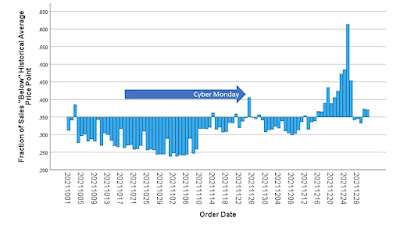It's the day that trade journalists and vendors praise companies for selling a $50 item that costs the brand $25 for just $30. They smugly suggest that all of the additional "traffic" will make up for the $20 of gross margin dollars you give up to make a theoretical "consumer" happy.
a) Selling a $50 item that costs you $25 gives you $25 of gross margin.
b) Selling a $30 item that costs you $25 (40% off, woo-hoo) gives you $5 of gross margin, requiring 5x the traffic converting at the same rate for you to make the same amount of profit.
I've told you this story before ... but it symbolizes Cyber Monday. I'm sitting in an Executive Meeting (as a consultant) at 8:00am on Cyber Monday. An employee walks into the room, hands the CEO a folded piece of paper. The CEO opens the folded piece of paper in a manner not unlike a 16 year old boy would in high school chemistry after having the paper passed across six desks from a girl named Becky, reads the contents, looks up, and then pauses the meeting. He addresses the room.
"Brand X just announced they are at 50% off today. Fifty percent! We're only at 40% off. If we want to remain competitive, we need to be at 50% off today as well. Charlie (the marketing executive), tell you team to redo the creative on the 9am blast and switch to 50% off. Have them create a new discount code and get that code on the website as soon as possible." Charlie, the CMO, headed out of the room with a look on his face like his scrambled eggs for breakfast weren't fully cooked and his tummy was just realizing that fact.
Humans.
Here is a chart from a company that doesn't even care all that much about Cyber Monday. We look at percentage of sales that day that come from items selling below their historical average price point. Tell me what you see.
Yeah, for one day they just gave some merch away in an effort to please, well, um, I have no idea who they were trying to please. By the way, if you average sales for the Monday before Cyber Monday and for the Monday after Cyber Monday, you learn (for this brand) that sales did not increase on Cyber Monday. Prices were lower, profit was lower, sales were identical.
Notice the heavy discounting in the week prior to Christmas. This company switches into "liquidation mode" and starts moving out winter stuff in anticipation of Spring/January.
In mid-November, the brand begins to discount more. The brand discounts even more on Cyber Monday, then reverts back to pre-Cyber-Monday behavior, before clearing out stuff in late December.
What does the graph depicted above look like for your brand?


No comments:
Post a Comment
Note: Only a member of this blog may post a comment.